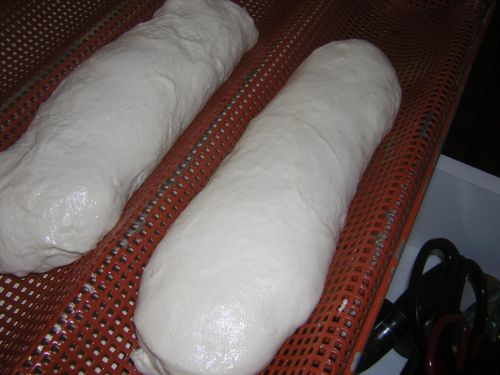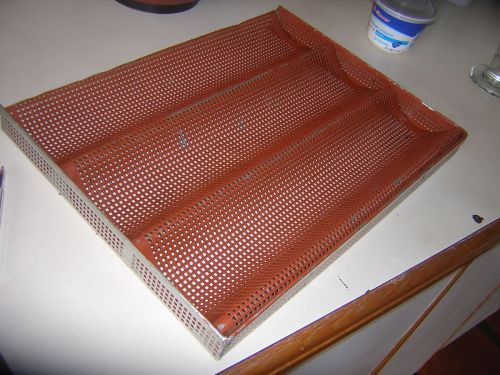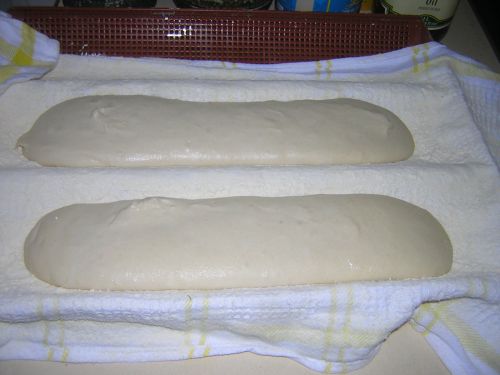-
Posts
507 -
Joined
-
Last visited
Content Type
Profiles
Forums
Store
Help Articles
Posts posted by gsquared
-
-
snip..
Puzzled about the dormant performance of your breads, Gerhard, I decided to see how I fared with Jack's baguette formula, having never used 100% plain flour for breads before. Initially, I thought of doing the no-time method (which, again, I've never done before) but I had a glitch with my food processor...so back to Dan's familiar method.
snip..
I think I hate you. No, I know that I hate you. In fact, I hate all bread bakers.

That looks simply great, TP. In fact, that is exactly how I want mine to look. You have given me great encouragement. Thanks.
-
That's one heck of an experiment. I'm impressed.
I'm wishing you all the best in coaxing the b(y)eastie boys into playing nicely with others. There's something inherently absurd in many serious endeavors. Good Luck! And lots of laughter.
I keep wondering if the local humidity makes a difference. Also, what cleaning materials are used on the 'folding' board? And if you are using oil at any stage, what kind? I have no idea what to do with the answers tho.
I thank you for this thread, because its providing me with such an education. I've made sourdough before, lo these many years ago, but never with the kind of analytical approach being tried. Its really great.
Humidity is high - generally around 85%. For the rest, nothing springs to mind. I will post the start of the experiment below, but will privately confess that I have made a real mess of the kitchen. Somehow transferring the (intended) leftover preferment to the mother, half of it landed on the floor. The dogs attacked it with gusto. I chased them off and they have been leaving a trail of preferment though the house. The Artist is not giggling.
-
I went through this problem of trying to bake bread in Israel. I do not have central heating and air conditioning in my house. The flour is different from the type I was using in the States and Europe.
snip...
Maybe you are having the same problem I had. One works in one place does not always work in another. I would talk to your local bakery and ask them for advice in regards to climate, flour types, etc.
That looks sooo good, Michelle. There is hope after all! I am so pleased that I am not alone.
-
The preferment after 8 hours. No doubt that it is alive.

-
I am waiting with bated breath for the outcome of today's experiments. I can hear Gerhard now, "Sorry, guests. I can't serve your needs right now cuz I have to stay in the laboratory, er, kitchen, to supervise my doughs." I imagine the Artist is either hovering nearby or staying far, far away.
snip..
Wishing you at least one loaf of successful bread today, Gerhard!
The Artist, Lori, is a fount of useless advice in this endeavour. "Play it some Mozart" she shouted last night, giggling like train. As a person attempting to apply the scientific process, I did not find it particularly helpful. Not the advice nor the giggling.
Thanks for the good wishes.

-
ooh this is interesting...
I think you either have to minimally develop the gluten (short mix, then stretch and fold), or go all he way and over develop it (intensive mix, then relax). Yu can make good bread either way.
However the problem here is we don't seem to be getting any rise at all. Maybe the environment is such it just needs much longer, or something is killing the yeast. We need to sort that out first, before the fine details of technique,
Do you think going for all 5 methods is overkill, Jack? It seems to me that one of three results are possible:
1. No rise in any of the 5 batches. Assuming, as we must, that the yeast is alive going in, that would mean that something is killing it later. This result would be the least desired, as I have no idea where we go from there.
2. Some rise and some don't or not to the same extent. That would point to the mixing method.
3. All rise. That would leave me flabbergasted. And discombobulated.
I have just had a short siesta. It is going to be a long evening.
-
something killing the yeast? what kind of water are you using? and what kind of salt?
I don't think so. Bottled mineral water and Maldon salt.
-
hmm..maybe the slow process isn't right then.
However we need to do something just to get it moving at all, even if the bread is not optimal.
AS you say, monitoring might be the way. When you make the dough tomorrow shorten the mix time to say 1min, just in case it is overheating. Cut off 100g and put it preferably in a glass measuring jar, or failing that straight-sided tumbler (they are called slim jims here), and mark how far up it comes.
Keep it with the bread. It should about double in volume when the bread is ready to bake...It will at least let us see if there is any activity.
Here is then the plan for today:
1. Make the preferment. I'll quintuple the quantities. And add an extra one to return to the mother.
2. Mix two batches in the food processor, one for 1 minute, one for two minutes. Take the temps.
3. Make one batch with Dan's folding method.
4. Make one batch in the mixer with the dough hook.
5. Make one batch in the bread machine.
6. Set up five jars, with 100g from each batch. Mark the jars. Form the batches into balls. Label the batches. Place with jars in the proving environment.
7. Take jar measurements every 30 mins.
It is maybe overkill to do 4 and 5, but if this is to be a day of experimentation, it may be interesting.
-
Have you considered using a bread machine for mixing the dough?
snip
You know, Andie, that I have to agree with you. If it were not for the bread machine I would not now be making bread! I have abandoned it for some time now and make all my breads with the KA and my hands but the bread machine gave me decent breads that boosted my confidence so I can now live without it. I think that Gerhard mentioned at one point that he had one on order?Anna, my bread machine has arrived. I think that Jack prefers the minimal kneading approach. I seem to remember him writing in another thread that the hydration is the main driver for gluten development, and not the kneading. Vide Dan Lepard's folding method where there is to all intents no kneading at all. Perhaps Jack could expand on this.
-
And has anybody asked yet?
HOW DOES IT TASTE???
The crust tasted fine.
Maybe the Zen thing is where I come up short. I am more a "The algorithms of bread baking" type of person.
-
For the nonce, I am off to bed. To sleep, perchance to dream of bread.
-
My experience (I've been learning in a very concentrated, self-taught way, talking to people who know what they're doing, reading as much as I can get my hands on and baking and experimenting all the while for going on 5 years now) has indicated to me that the less you actually work a dough, the more beautiful the crumb, and the better it will behave for you.... That, of course, comes with dozens of caveats that you figure out as you learn. I don't use any mixers or processors for my breads. I use the turn and fold method, and I work with big bins of the stuff at a time, making 20 loaves of one formula at a time. And I work with very wet doughs. And a sourdough culture that is like manna. I'm in love with my sourdough culture and my breads just keep getting better.
Yeah, it is sort of labor-intensive, but only every couple of hours in short spaces of time. And I really don't know right now that to do it the quick and easy way will get you exactly what you're looking for. Maybe I'm wrong about that. In my gut, I don't think so. One of the reasons we've all been eating such degraded breads for so many years was that desire for the quick and easy process. Hence commercial yeast. Hence quick, warm rises. Hence tight crumb and weak crust and an inferior, flavorless product once you factor out the butter or jam.
Personally, I'm watching you work through a process here very quickly and actually getting very good results in a short period of time. Nope, it's not perfect. But to expect perfection right off the bat isn't reasonable.
Beautiful, gorgeous, flavorful bread is as much art as science. It takes a lot of time to get there. It takes a lot of failed bread. It takes a lot of desire to keep trying after every failure.
Frankly? Your first failures look way better than my first failures did.
Much food for thought there, Devlin. Thanks. I wish that you were producing your bread next door. I share your sentiment regarding the quick and easy culture and would love to apply its antithesis to my breadmaking. There has, however, to be middle ground somewhere. I am not and never will be dedicated to bread making. I love good bread, and would love to serve my guests a decent loaf, but my life is simply too full of other things to allow the attention required by the slow process. I know that it will simply not work. The day of an innkeeper is punctuated by interruptions. It is not so much the time, as it is the requirement to attend to a process at reasonably precise intervals. I take your point regarding quality vs. time, but there has to be a compromise that will allow me to produce decent bread, not perfect, not breathtaking, but simply decent within the contraints imposed by what I have to do to keep the inn.
If that is a chimera, then so be it. I am not ready to accept that. Not with Jack lurking. And thinking. I hope.
-
I wonder if using the stretch and fold method of mixing might give more control:
Here's how. Its essentially a version of Dan Lepard's method.
Instead of using the mixer to make the dough, mix by hand (or a spoon) in a bowl. Doesn't have to be perfect, just roughly even. Cover the bowl and leave for 10 minutes. Wash off the bits of dough stuck to your fingers
After 10 minutes Oil your work surface and your hands, turn out the dough onto the work surface, Basically you need to need to stretch and knead 30 seconds or so - for example fold in three, sides to middle, then top to bottom, then form a ball as you have been doing. Wash out the bowl and lightly oil it, then put the dough back in it, cover it and leave in a warm place for another 10 minutes. Do this twice more - half an hour in all.
Cut off about 100gm of dough and put it in a glass measuring jug, if you have one, and leave it in your warm place. This is your tell-tale and timer. The dough should roughly double in volume by the time the bread is ready to bake.
Then do the same stretch and fold every half an hour for another 2 hours, or until you see little bubbles appearing when you make a cut in the dough. If the bubbles aren't there leave it longer, stretching and folding every hour until they appear.
When the small bubble are present, shape the dough and leave in warm place, covered for 2 hours or so before baking.
Does this mean that you think that the food processor is the problem? I will do the folding bit if you are sure that this is the only way of eliminating the most likely problem. I am not too keen on the amount of interaction required, at least not as a permanent solution. There is no way that I can set aside 2.5 hrs every day to be available for the folding. Also, the timing is out for baking for breakfast, unless I can still retard in the fridge.
How about simply doing the food processor whizzing and then taking the temp of the dough. If it is ok, it cannot be the food processor doing the damage. I am really keen to retain the food processor part, because it is so quick and easy. Please rethink - the more I think about Dan's method, efficacious as it may be, the more I realise that the exigencies of my life would not allow it as a daily routine.
If the food processor is not the culprit, I am at a loss where to go from there. That is, assuming the the dough temp is fine. Is there any way to determine whether the dough, after proving, has had yeast activity? Drop a ball into hot oil?
-
I'm really really puzzled.
Lets take it form the top.
You make the preferemetn with 100g of waer and 100g of flour and a spoonful of mother starter
You ferment this for 12 hours at 30C until bubbly (I've seen it)
You then mix all the preferment with 500g of flour, 300g of cold water and 12g of salt (the Vit C helps but is not essential)
Shape and let prove at 30C for 2-4 hours...
Bake at 250C roughly for 40 mins.
Something must be killing the yeast during or after you have mixed it. How hot is the dough when you take it from the mixer? Should be warm, not hot...
Correct on all points. I also did not sing.
Not hot. Warm. It is still a possibility - I did not concentrate on the temp of the dough. Although I think I would have noticed if it was hot. I'll take its temp next time around. This seems to be the only point where the yeast can get killed off, isn't it. Assuming that the yeast in the preferment is ok. Can the foaming only be attributed to activity by good yeast?
Can we perhaps debug this by inserting checks at crucial points, even if it means a day or two spent doing just that without an actual baking attempt?
-
By the way, the baguette pan I used, the type that looks like expanded metal, is no good for baking a wet dough. The dough seeps (slithers?) minutely through the small holes during proving. Baking then expands the "seepage" on the wrong side of the pan to anchor the bread securely to the pan.
For tomorrow, I am back to linen. And rice flour.
-
So here we are:- another failure to report:

I did not think that this was going to be easy - if it was, I would have got it right about 3 years ago. Maybe it is easy, just not easy for me. In any event, not ready to give up.
JACK?
-
Today's effort under way. Here are the loaves before proofing:

And after 2 hours, just before slashing and baking:

In the oven right now.
What bothers me is that there is so little difference between the pre- and postproofed loaves. I would have expected some evidence of activity....
-
Jack, to summarise, the plan for the day is to leave the preferment for the full 12 hours, then mix using 300g water (with the preferment that gives 66% hydration, right?), proof for 2 hours in the baguette pan and then bake.
As an aside, I found it difficult to get the Magimix going again if I stop halfway through whizzing. The dough wrapped around the spindle and the machine started labouring. I had to stop it to add the ascorbic acid. Is this normal or indicative of anything significant regarding the consistency of the dough?
-
snip..
Remember, you didn't learn to walk the first time you stood up so keep trying.

Thanks.
You are right about the walking. But I could recite "The boy who stood on the burning deck" at 3.

-
Still here to encourage you Gerhard, It s like following the olimpic games , next try will be the one , and you know what even if isnt who cares are you in a hurry??
No You have all the time you want , its a learning process it takes time and patience,and one important thing , dont forget to have fun meanwhile , if there isnt fun there is no point on doing it .

Amen on the fun. I have always believed that, in matters where you have a choice, if you don't have fun doing it, stop doing it. That is why I retired early.
-
Thanks to everybody for all the good wishes and encouragement. I am still of good cheer. The preferment is made and fermenting away.
Jack, I think I will use the baguette pan for proving and baking. It makes sense to get to a good loaf first via the easiest route and then get the couching bit sorted out.
Adding insult to injury:
Four guests told me at breakfast yesterday that they would be visiting Knysna and would bring me a baguette from Ile de Pain, a famous bakery on Thesen Island. Bless their hearts, I found this in the foyer this morning. They had no idea of my delicate state, of course.......

Jack, can you explain the knobs at the ends? Simply a sort of trademark, or does it have any significance?
-
sigh...lots of flour on the couche, Use the same cloth each time and don't wash it - sterilise it by drying it out in a low oven. It builds up a sort of easy release layer. Some people use rice flour,
A slightly drier dough can help, but we did that,
You can get baguette pans made from silpat like material or even tin, and proof them in those. Grease them well, or you just get the cooked loaves stuck. They always leave an impression on the bottom of the loaf, so traditionalists disapprove.
The blade used to slash is called a lame (blade in french)
Not a good bread baking day, Jack. I am retiring to lick my wounds. I refuse to post pics of today's attempt. When I pre-heated the oven I used the thermofan setting as I always do. This time I forgot to turn the thermofan off when I put the loaves in. Must be the panic at not getting them out of the couche. Thermofan at 240 = normal oven at 280. Loaves burnt and discarded - even the seagulls would turn their noses up. Sorry about that. Shall we cancel today and repeat exactly the same procedure (without the sticking and burning bit) tomorrow? I have a baguette pan, so maybe the more we can do right now to focus on getting the dough right, the better.

Question: if you prove in the baguette pan, and then put the pan in the oven, is the oven spring less? If so, how do you compensate for that?
-
Disaster! The shaped loaves got totally stuck to the couche and would not release. I had to tear them off, losing all shape. And whatever rise there may have been. I reshaped, slashed, and stuck them into the oven in any event.
I had less difficulty yesterday in the process couche-to-peel-to-oven, but it was still a hassle. Is there any easier way?
-
2 hrs 45 mins. Some rise, I think. Or is it my fevered imagination?
The oven is pre-heating, the slash thingy (term pse Jack?) is sharpened. I am halfway through a bottle of Blauwklippen Cab 2002. Stop pacing, Jack, you are making me nervous.




The rehabilitation of a failed baker
in Pastry & Baking
Posted · Edited by gsquared (log)
First part of the experiment is underway.
The test jars:
Improvised bannetons for the dough:
I am doing the folding one now - it will lag behind the others by the 2h40mins needed to make it. Folding the dough started me thinking about Devlin's post upthread. I have lots to ponder on.
The temp of the 1 min whizz was 29C, the 2 mins 35C.